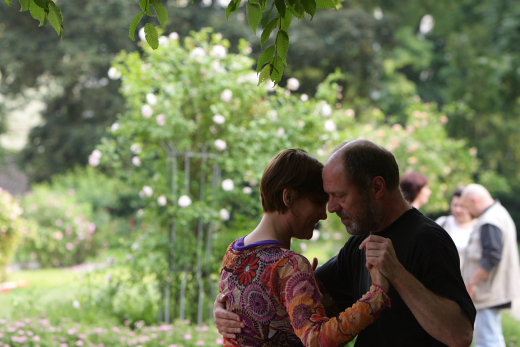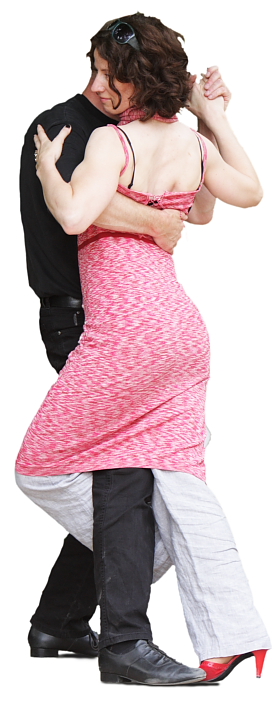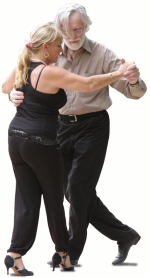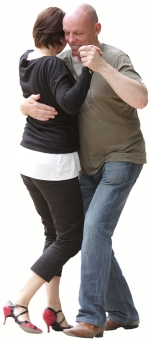1
Milonga: A Closer Look At Tango.
Text: Kerstin Lange
Photography: Helmut Römhild
he wanted to enhance the musical possibilities of the concertina.
And for quite a while the guitar accompanied the first dancers doing the Tango in the slums of Buenos Aires.
But there was nothing to stop the success story of the Bandoneon as the Tango’s main instrument: “From its very beginnings Buenos Aires had been waiting for the Bandoneon, like the Pampa which - for millennia - had been waiting for the horse.”
The Tango: Not only a dance with a dedicated instrument.
It’s also a dance with a very special set of rules – rules not really related to dancing.
For example don’t forget the following:
The gentleman asking for the next dance always presents himself to the lady in full view, approaching from the front. Eye contact precedes
the move, the lady using this way to consent or reject. After the dance the gentleman leads the lady back to her table, withdrawing immediately, never
imposing himself onto his dancing partner ...
It’s all about the real man and his honour – welcome to the macho universe!
A code of conduct for real men, a concertina made in Germany, and a couple of dancing steps –
this can’t be all, can it?
A few days later I have the chance to find out more, at a place where they dance the original from Argentina.
The town is still Hamburg, Germany, because I’m following the advice of Hector Falcon, a master of the Tango Argentino:
“Another important thing about the Tango is that you can dance in any part of the world at a Milonga.
Even if you don’t speak the language...”
“Next Sunday, at the park.” Tango trainer Ingrid Saalfeld is on the phone. “If the weather’s fine.”
It is Sunday, the weather is ok, the roses are in full bloom.
The car is parked – and now?
We do what all dancers do: we follow the music.
And what is playing in the distance is without doubt a Tango.
This must be the place.
Milonga at the park: at least four or five couples are on the dancing floor.
Dancing floor? This is a dancing floor?
“Five by five meters, wood.” Ingrid seems to be proud.
But of course, now I remember: The Tango Argentino dancer prefers crowded places, dancing on an overcrowded floor
is regarded as the ultimate challenge, to succeed demonstrates superior skill.
But wait a minute! This is not a Tango. This is a Walz, a real Viennese Waltz –
although this one is not from the River Danube but from the Rio de la Plata, played by a Bandoneon.
But even if this one is called ‘Vals’ it is nevertheless a ‘Viennese’.
Which makes me think that dancers need at least 5 times more space to ‘take off’ with a walz.
But on this miniature floor? Impossible!
Impossible?
There are six couples having a lot of fun while I try in vain to identify any Viennese Waltz figures.
No surprise: it’s Tango what the dancers do, even if the music is a ‘Vals’.
One more piece of music, the couples split and the gentlemen accompy new partners to the floor
Ingrid Saalfeld owns the Tango school ‘Funtango’.
She is Tango trainer with more than 20 years experience and learned the Tango
at Buenos Aires.
Funtango
www.tango-con-pasion.de
Quotations:
Buenos Aires and the Bandoneon – quoted from
A. Birkenstock, H. Rüegg, ‘Tango’, 2000, 2. edition, p. 80
Hector Falcon and Rodolfo Dinzel – quoted from interviews with Jackie Ling Wong on the ‘Tango Pulse’ website.
‘Tango Pulse’
http://tangopulse.net/
I see dancers who prefer a little space between them and dancers in close embrace,
I see ladies carefully checking each step and other ladies who follow the lead with eyes closed.
About leading Hector Falcon explains: “ I lead – a question, I ask. And when my partner does something, it is an answer. Sometimes, with a question my partner will answer in a different way and then I need to ask a different question. Sometimes you have to say your question louder. ”
steps which are basically some kind of building blocks: that much I already understood.
And something is constructed this way. But what?
Wolfgang: “I’m an actor at the theatre and a musician.
I visualize music and through dancing I try to give shape to these pictures.
This is my way to express emotions which sometimes is difficult for men. But it is very important
and I pity all who cannot share what’s happening here.”
Hannelore started dancing Salsa but abandoned it for Tango Argentino:
“Eventually I spent several weeks in Buenos Aires staying with a girlfriend.
The trainers came to my place every day and we danced the tango.”
It’s Monday evening: Training session at the ‘Funtango’ dancing school, Tango for beginners,
for people with no experience.
‘No experience’, that’s me, no doubt:
I make a few initial steps and end on a lady’s toes.
The lady’s name is Rosi and she’s quite relaxed: Playing the gentleman’s role also includes
sacrificing the shoes while leading an absolute beginner like me.
During 8 years of ballroom dancing Rosi learned to put up with that sort of aggravation, meanwhile she prefers the Tango Argentino over
Walz and Co, the Tango making it easier for her to balance activity and fun.
although I brought a guy of my own. But he is busy right now.
His lady is rather delicate, at least one head smaller, and he is anxious to keep her in one piece.
A tough job, looking at his face I can read his expression:
Where the hell is she now? What’s she doing? What am I expected to do?
To switch dancing partners is a characteristic of Tango Argentino, that ladies dance together is quite usual,
also the gentlemen show each other the twists and turns of Tango.
Singles love the Tango Argentino for an obviouos reason:
frequently changing the dancing partners means that everyone has a chance to dance.
Again the dancing floor is rather small, quite crowded, there are a few rules to abserve:
Move anti-clockwise; always be aware what the others do; never interfere with other couples, avoid to annoy the other dancers.
Move anti-clockwise? Good idea if only I were able to follow the lead.
Floorcraft? Might perhaps improve if I look at my feet?
No, not to be recommended, keep the chin up, the only chance to see what the others do.
Beginners avoiding close contact get into trouble: Each dancer is doing what he or she can do and thinks is appropriate creating
a small scale havoc ...
Stop. And start all over again.
And change dancing partners.
My husband and myself get ready, head turned to the right.
“Heart to heart,” Ingrid explains correcting our posture until our left sides are turned towards each other.
Centre of body mass shifts forward, there is still some space between us, my husband will have to lead with arms and hands.
We begin to dance by swaying a little bit, concentrating on the music, getting into the rhythm.
The beginning: 3 steps.
The walk: 2 steps, then again 3 steps – the ending.
Rodolfo Dinzel, another master of Tango:
“... we are always improvising. We never repeat anything. Tango is about here and now and it is always changing.
We hear the music and respond.”
Now the gentleman stops, walking on the spot.
I move sideways, crossing my feet in front, then behind: a Tango turn!
Now the other way round.
And again the other way round, then again to the left, then to right, left again, again to the right, left, right ...
The foot of my free leg is trailing, drawing a figure eight on the floor, the eight is the name of what I’m doing here: Ocho.
Suddenly the basic steps are boring, my feet want more.
It seems to be the music:
I no longer hear only the 4 simple beats, now I hear something far more interesting.
Slow, slow, quick, quick? Works fine!
Slow, quick, quick? Great!
Suddenly we are having fun, suddenly we realize how it could be if done correctly, with the right skills:
The lesson is over in no time and I learned a couple of things
on that small, crowded floor.
It was not so much about Tango steps.
It was about following the music, it was about being able to hear what the music wants from me,
to understand the possibilities.
My husbands is looking at his feet where
the ladies’ Ochos and cross steps left scratches and streaks of dust –
apparently he is not opening doors for the ladies but standing in their way.
My shoes and trousers more or less look the same showing that I still have a long way to go to become a Milongera.
But I’m convinced that this wasn’t our last Tango.
Next time we will be better.
And if we are lucky the music will again for one moment play only for us ...
From the Rio de la Plata Into The World.
The Tango Argentino, at home in the States of the Rio de la Plata and born in Buenos Aires, is regarded als the original Tango.
In the beginning it is a dance of the poor, the prostitues and the criminals but soon fascinates the respectable people and upper classes.
Nevertheless it collides with the conventions of a strict society. The Tango is outlawed by politicians and clerics.
Around 1912 the dance invades Europe, especially France is virtually infected by ‘Tangomania’. Europe favours the ‘Salon-Tango’ stile
which becomes predecessor of today’s ‘Standard Tango’.
With Tango being a Paris trend also the Southern American societies finally accept their Tango culture.
Tango music becomes more and more complex and demanding, the dance more elaborated. The Tango survives 2 world wars and spreads all over the globe.
It’s not the church or social convention which finally deals the death blow to Tango: it’s Rock’n Roll. When in the 1960ies the era of ballroom dancing
ends also the Tango Argentino dies.
In Argentina the dictators take over government and erase Tango culture from everyday life, it’s virtues of personal strength, individuality and
tradition incompatible with totalitarian states.
Banning assemblies of more than 2 poeple, curfews and other harassments make Tango dancing illegal, dancers and musicians are suddenly criminals and
forced into exile in Europe and the US.
After the collapse of the dictatorship the Tango is revived and today not only part of everyday life but also part of the national identity
of Uruguay and Argentina.
Tango culture is supported by the governments, Tango masters like Rodolfo Dinzel and Hector Falcon today are famous professionals.
Tango Argentino is not a standard dance, there is no official set of figures which can be learned.
To learn the Tango means to dance – as much as possible with as many dancing partners as possible.
Dancing at a Milonga, the traditional ‘ball’ of the tango dancers, still is regarded as the ultimate challenge: to create
a private sphere on the crowded floor whithout interfering with the other couples is considered superior skill.
Dance and Tango music are inseparable.
The origin of Tango music are rather simple pieces, performed by duos and trios with a guitar as the main instrument.
Between 1935 and 1955, called the ‘Golden Age’ of Tango, the music, now complex and demanding, is performed by large orchestras.
Finally, in 1970ies, Astor Piazolla makes the Tango part of the repertoire played in the international concert halls.
The characteristic instrument of Tango music is the Bandoneon, the push-button concertina from Germany, constructed in the 1850ies by Heinrich Band
and developed into a global success.
The Doble-A version by Alfred Arnold with it’s 142 notes combined into almost 5 octaves is still regarded the superior instrument.
Played by a virtuoso the Bandoneon is equal to strings and wind of large orchestras.
![]()
©: Ballroom Website, 2009
Updated: 05.07.2009





